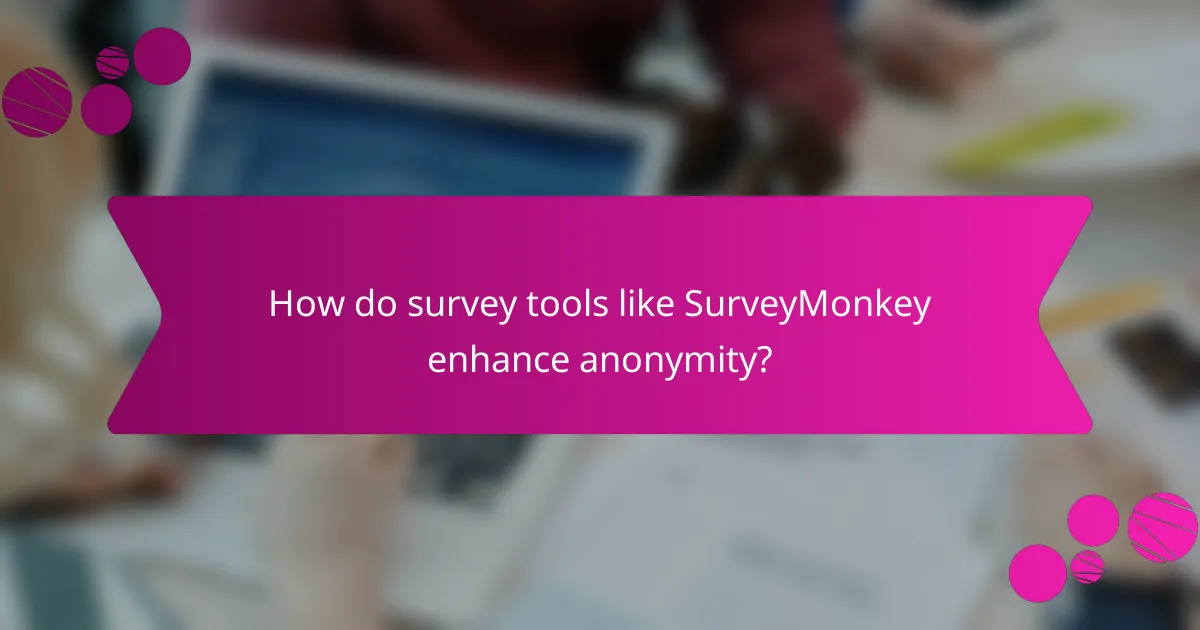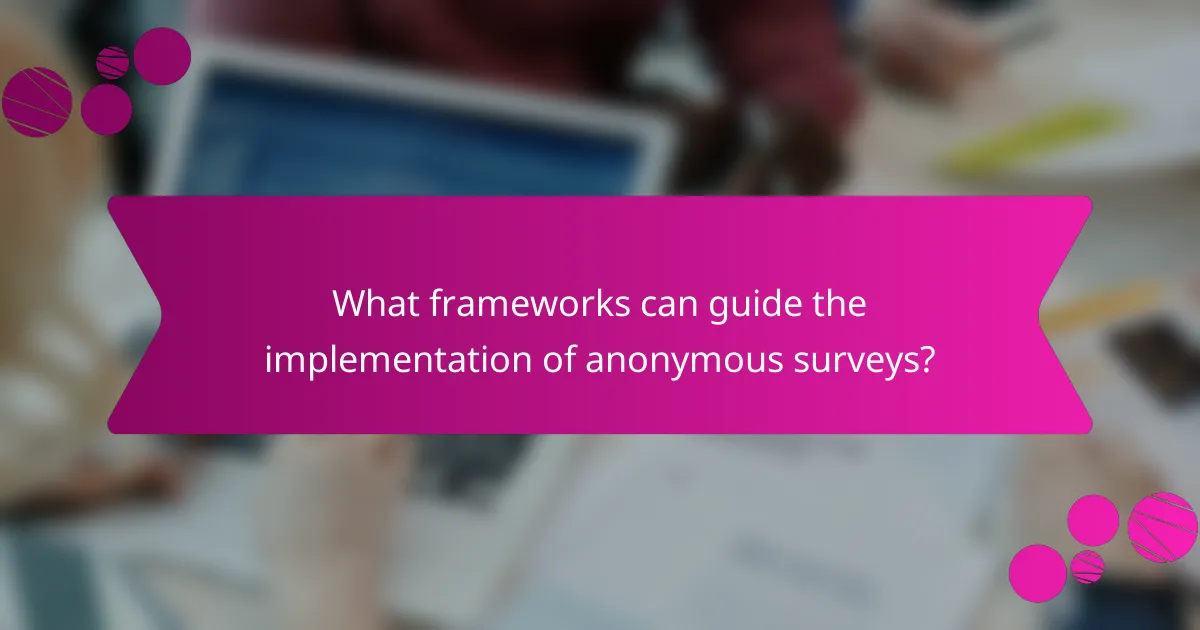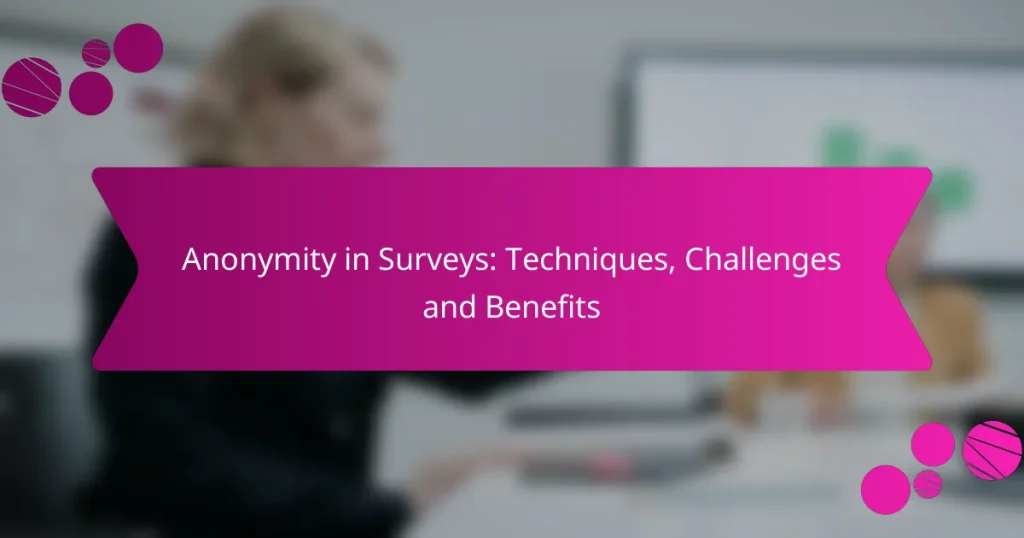Anonymity in surveys is crucial for obtaining honest and reliable responses from participants. By employing effective techniques such as anonymous response collection and data encryption, organizations can protect respondents’ identities while still gathering valuable insights. However, challenges such as data linkage risks and compliance with regulations must be navigated to maintain the integrity of anonymous surveys.

What are effective techniques for ensuring anonymity in surveys?
Effective techniques for ensuring anonymity in surveys include anonymous response collection, data aggregation methods, the use of pseudonyms, encryption of responses, and utilizing third-party survey platforms. These strategies help protect respondents’ identities while still gathering valuable data.
Anonymous response collection
Anonymous response collection involves designing surveys in a way that does not link responses to individual participants. This can be achieved by avoiding personal identifiers and using unique codes instead. For example, a survey could assign a random number to each participant, ensuring their answers remain confidential.
When implementing this technique, consider using drop-off boxes or online platforms that do not require login credentials. This approach can significantly increase response rates as participants feel safer sharing their opinions without fear of identification.
Data aggregation methods
Data aggregation methods involve compiling responses in a way that obscures individual contributions. By reporting results in groups or averages, researchers can present findings without revealing personal data. For instance, instead of showing individual answers, a survey might report that 70% of respondents prefer a certain product.
To effectively use data aggregation, ensure that the sample size is large enough to prevent any single response from being identifiable. This technique is particularly useful in sensitive topics where individual responses could lead to potential backlash.
Use of pseudonyms
The use of pseudonyms allows participants to provide their input without revealing their true identities. By assigning a pseudonym to each respondent, researchers can collect data while maintaining anonymity. This method is particularly effective in qualitative research where open-ended responses are common.
When using pseudonyms, clearly communicate to participants that their real names will not be associated with their responses. This reassurance can encourage more honest and open feedback, especially on sensitive subjects.
Encryption of responses
Encryption of responses protects data during transmission and storage, ensuring that only authorized individuals can access it. This technique is crucial for maintaining confidentiality, especially when surveys are conducted online. Using encryption protocols like SSL (Secure Socket Layer) can safeguard responses from potential breaches.
Implementing encryption requires technical expertise, so consider working with IT professionals to set up secure systems. Regularly updating encryption methods and software can also help protect against evolving security threats.
Third-party survey platforms
Utilizing third-party survey platforms can enhance anonymity by managing data collection and storage independently. These platforms often have built-in features that ensure responses are anonymous and secure. Popular options include SurveyMonkey and Google Forms, which offer various privacy settings.
When choosing a third-party platform, review their privacy policies to ensure they comply with relevant regulations, such as GDPR in Europe. This step is essential to guarantee that participants’ data is handled appropriately and securely.

What challenges do organizations face in maintaining survey anonymity?
Organizations encounter several challenges in maintaining survey anonymity, including data linkage risks, participant trust issues, compliance with regulations, and technological limitations. Each of these factors can compromise the effectiveness and integrity of anonymous surveys.
Data linkage risks
Data linkage risks arise when survey responses can be connected to identifiable individuals through various means, such as demographic information or behavioral patterns. Even seemingly anonymous data can be re-identified when combined with other datasets, leading to privacy breaches.
To mitigate these risks, organizations should employ techniques like data aggregation and anonymization. However, these methods must be carefully implemented to ensure that they do not inadvertently allow for re-identification.
Participant trust issues
Participant trust is crucial for ensuring that individuals feel comfortable providing honest responses in surveys. If respondents believe their anonymity is not guaranteed, they may withhold information or provide inaccurate answers.
Organizations can build trust by clearly communicating how data will be used and protected. Providing assurances about confidentiality and sharing anonymization protocols can enhance participant confidence in the survey process.
Compliance with regulations
Compliance with regulations such as the General Data Protection Regulation (GDPR) in Europe or the California Consumer Privacy Act (CCPA) in the United States is essential for maintaining survey anonymity. These laws impose strict guidelines on data collection, storage, and processing, which organizations must follow to avoid legal repercussions.
Organizations should regularly review their survey practices to ensure alignment with applicable regulations. This includes obtaining informed consent from participants and implementing robust data protection measures.
Technological limitations
Technological limitations can hinder the ability to maintain survey anonymity effectively. Some survey platforms may not offer advanced features for anonymization or may lack the necessary security measures to protect sensitive data.
Organizations should evaluate survey tools carefully, prioritizing those that provide strong encryption and anonymization capabilities. Regular updates and audits of the technology used can help ensure ongoing compliance with anonymity standards.

What are the benefits of anonymity in surveys?
Anonymity in surveys enhances the quality of responses by encouraging participants to share their true thoughts without fear of repercussions. This leads to more reliable data, which can significantly improve decision-making processes.
Increased response rates
Anonymity can lead to higher response rates as individuals feel more comfortable participating when their identities are protected. Surveys that assure confidentiality often see participation rates increase by several percentage points compared to non-anonymous surveys.
To maximize response rates, clearly communicate the anonymity policy in the survey invitation and throughout the survey process. This transparency helps build trust and encourages more people to engage.
More honest feedback
When respondents know their answers are anonymous, they are more likely to provide candid feedback. This is particularly important for sensitive topics, such as workplace satisfaction or personal health, where individuals may otherwise hesitate to share their true opinions.
To foster honest feedback, consider using open-ended questions that allow respondents to express their thoughts freely. This approach can yield richer insights compared to multiple-choice questions.
Higher quality data
Anonymity contributes to higher quality data by reducing bias and social desirability effects. When participants feel secure, they tend to provide more accurate and thoughtful responses, leading to data that better reflects the true sentiments of the population.
To ensure high-quality data, design surveys that minimize leading questions and encourage genuine responses. Regularly review and refine survey instruments based on feedback to maintain data integrity.
Protection of sensitive information
Anonymity safeguards sensitive information, protecting respondents from potential negative consequences of their responses. This is crucial in areas such as mental health, financial status, or personal beliefs, where disclosure could lead to stigma or discrimination.
Implement robust data protection measures, such as encryption and secure storage, to further enhance the confidentiality of survey responses. Clearly outline these measures in your survey documentation to reassure participants about the safety of their information.

How do survey tools like SurveyMonkey enhance anonymity?
Survey tools like SurveyMonkey enhance anonymity by offering features that protect respondents’ identities while collecting valuable feedback. These tools implement various methods to ensure that responses remain confidential, encouraging honest and candid participation.
Anonymous survey options
Many survey platforms provide options to create completely anonymous surveys, meaning no identifiable information is collected. Users can select settings that prevent the collection of IP addresses or email addresses, ensuring that responses cannot be traced back to individuals.
For example, SurveyMonkey allows users to toggle anonymity settings when creating a survey, which can significantly increase response rates as participants feel safer sharing their opinions without fear of repercussion.
Data privacy features
Data privacy is a critical concern for survey tools, and many platforms comply with regulations such as GDPR or CCPA. These regulations mandate strict guidelines on how personal data is handled, ensuring that survey responses are stored securely and used only for intended purposes.
SurveyMonkey, for instance, employs encryption and secure data storage practices to protect respondent information. Users can also review privacy policies to understand how their data will be managed and what measures are in place to safeguard it.
Customizable response settings
Customizable response settings allow survey creators to tailor the anonymity level according to their needs. Options may include allowing respondents to skip questions, providing open-ended responses, or limiting the number of times a survey can be completed from the same device.
By adjusting these settings, survey creators can strike a balance between gathering useful data and maintaining respondent confidentiality. For example, enabling open-ended questions can lead to richer insights without compromising anonymity, as long as personal identifiers are not requested.

What frameworks can guide the implementation of anonymous surveys?
Frameworks for implementing anonymous surveys focus on ensuring participant confidentiality while collecting valuable data. Key approaches include utilizing secure data collection methods, establishing clear privacy policies, and adhering to ethical guidelines that protect respondent identities.
Best practices for survey design
Effective survey design is crucial for maintaining anonymity and encouraging honest responses. Start by using online survey tools that offer anonymous response options, ensuring that no identifiable information is collected. Keep surveys concise, ideally under 10 minutes, to minimize participant fatigue and improve response rates.
Incorporate neutral language and avoid leading questions to reduce bias. Use a mix of question types, such as multiple-choice and open-ended questions, to gather diverse insights while allowing respondents to express themselves freely. Regularly test surveys with a small group before full deployment to identify potential issues.
Ethical considerations
Ethical considerations in anonymous surveys revolve around participant rights and data integrity. Always inform participants about the purpose of the survey and how their data will be used, even if their identities remain confidential. Obtain informed consent, ensuring that respondents understand their participation is voluntary and that they can withdraw at any time.
Additionally, comply with relevant regulations, such as the General Data Protection Regulation (GDPR) in Europe, which mandates strict data protection measures. Regularly review and update your privacy policies to reflect best practices and legal requirements, fostering trust and encouraging participation.

How do cultural differences impact perceptions of survey anonymity?
Cultural differences significantly influence how individuals perceive survey anonymity. In some cultures, there may be a strong emphasis on collectivism, leading to heightened concerns about privacy and data sharing, while in others, individualism may foster a more relaxed attitude towards anonymity in surveys.
Understanding cultural attitudes towards privacy
Cultural attitudes towards privacy vary widely. In cultures with high power distance, individuals may feel less comfortable providing honest feedback due to fear of repercussions. Conversely, in low power distance cultures, respondents may be more open, perceiving anonymity as a safeguard that encourages candid responses.
Impact on survey design
When designing surveys, it’s essential to consider these cultural attitudes. For instance, in cultures where anonymity is valued, using anonymous response methods can enhance participation rates. In contrast, in cultures where trust in institutions is low, providing clear information about data protection and anonymity can help alleviate concerns.
Strategies for improving perceived anonymity
To enhance perceived anonymity across diverse cultures, researchers can implement several strategies. Clearly communicate the purpose of the survey and how data will be used. Additionally, employing third-party platforms for data collection can help build trust. Offering incentives can also encourage participation while reinforcing the commitment to anonymity.


